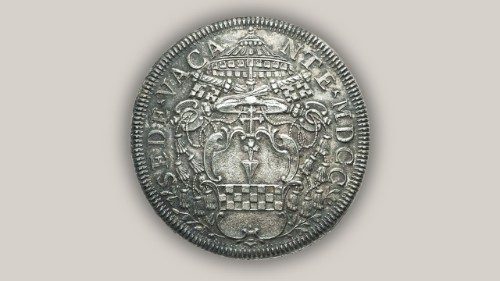
The Sede Vacante during the 2025 Holy Year evokes historical parallels with the Jubilee of year 1700 which was also marked by the death of a Pope, Innocent XII, who died before the end of the Holy Year he had proclaimed. The Numismatics Department of the Vatican Library preserves a commemorative coin of that Sede Vacante in its medal collection. Its Director Eleonora Giampiccolo speaks to Vatican News about that year and the similiarities between Pope Francis and Innocent XII.
The current Sede Vacante presents several similarities with the one of 1700. That year, Pope Innocent XII passed away before the Holy Year he proclaimed concluded, leaving the Church without its Pastor.

Pope Innocent XII, known for his frail health in later years, suffered from podagra, a form of rheumatic illness that prevented him from personally opening the Holy Door at Christmas in 1699. He died on September 27, 1700, at the age of 85. His death ushered in a nearly two-month period of Sede Vacante before the election of his successor, Pope Clement XI, on November 23.
The promise of the Holy Spirit not to leave the faithful orphans
To commemorate the nearly two months of vacancy in the Chair of Peter, a coin was minted and is now displayed in the medal collection of the Vatican Apostolic Library. On its reverse, the dove of the Holy Spirit is depicted with the Latin verse from the Gospel of John: Non vos relinquam orphans, meaning “I will not leave you orphans” (John 14:18).

“It refers to the death of Innocent XII but also conveys a clear message of hope for the Conclave that was soon to begin,” explains to Vatican News Professor Eleonora Giampiccolo, Director of the Numismatics Department of the Vatican Library.

Pope Innocent XII
Innocent XII and his option for the poor
“Orphanos” refers to the Christian faithful who were left without the spiritual guidance of Innocent XII, known as the “father of the poor,” whose approach bears a strong resemblance to that of Pope Francis.
He is remembered for his care for the poor and the marginalised: “During his pontificate, he initiated projects to help orphans and the homeless. One example is the institution he founded at the Lateran Palace or the San Michele complex in Ripa Grande, which housed young Roman orphans and taught them trades,” Giampiccolo said
But the similarities between the two Popes don’t end here. Upon his death, Innocent XII donated all his possessions to the poor, a move, the scholar noted, echoed in Pope Francis’ decision to give his belongings to support prisoner rehabilitation.

The reverse of the coin of the Sede Vacante of 1700
The Holy Spirit over the Conclave
“The dove of the Holy Spirit,” Giampiccolo further explains, “became a typical symbol of the Sede Vacante starting in the 17th century: it expresses divine guidance in the selection of the new Pope.”
At the bottom of this depiction on the coin’s reverse is the inscription Anno Iubil (“Jubilee Year”): unlike the Jubilee begun by Pope Francis this past Christmas Eve, the ritual opening of the 1700 Holy Year—traditionally performed with three hammer strikes—was not presided by Innocent XII due to his severe illness.
The Holy Door not opened by the Pope
The Cardinals were left with the decision to choose a substitute. The Camerlengo, the Vice-Chancellor, and the Dean of the College of Cardinals gathered. Due to the Dean’s poor health, the choice fell to the Vice-Dean, Cardinal de Bouillon. “He was the one who opened the Holy Door on Christmas night in 1699,” explains Giampiccolo. “When the annual medal of 1700 was issued, the engraver chose not to depict the Cardinal who had broken the wall, replacing the Pope, but instead portrayed the Holy Door already open and being crossed by a procession of faithful.”
The messages embedded in the coins
The coins and medals preserved in the Numismatics Department of the Vatican Library carry a powerful communicative force: “They were essential means of communication. The images on them were understandable even to those who couldn’t read,” the scholar says. “A coin is also a means of exchange, while a medal is primarily a document, a medium of communication. It becomes a document for us, the scholars of posterity.”
The Pope giving his life for the Church
Another medal symbolises Innocent XII’s closeness to the poor. On the front is a bust of the Pontiff; on the reverse, Charity is depicted helping the poor. “The inscription refers to a legacy. It cites the Book of Sirach, where it says that the lineage of the just will remain forever.”
Pope Innocent XII’s love for his children, for the Church, is also commemorated by a final, larger medal that Giampiccolo shows us: “It was crafted by a woman, Beatrice Amerani, a member of one of the most important families of engravers at the papal mint. On the reverse, a pelican is shown tearing open its own chest to feed its young with its blood.” This image traditionally symbolises Christ’s sacrifice and his love for humanity.
Credit: Vatican News
